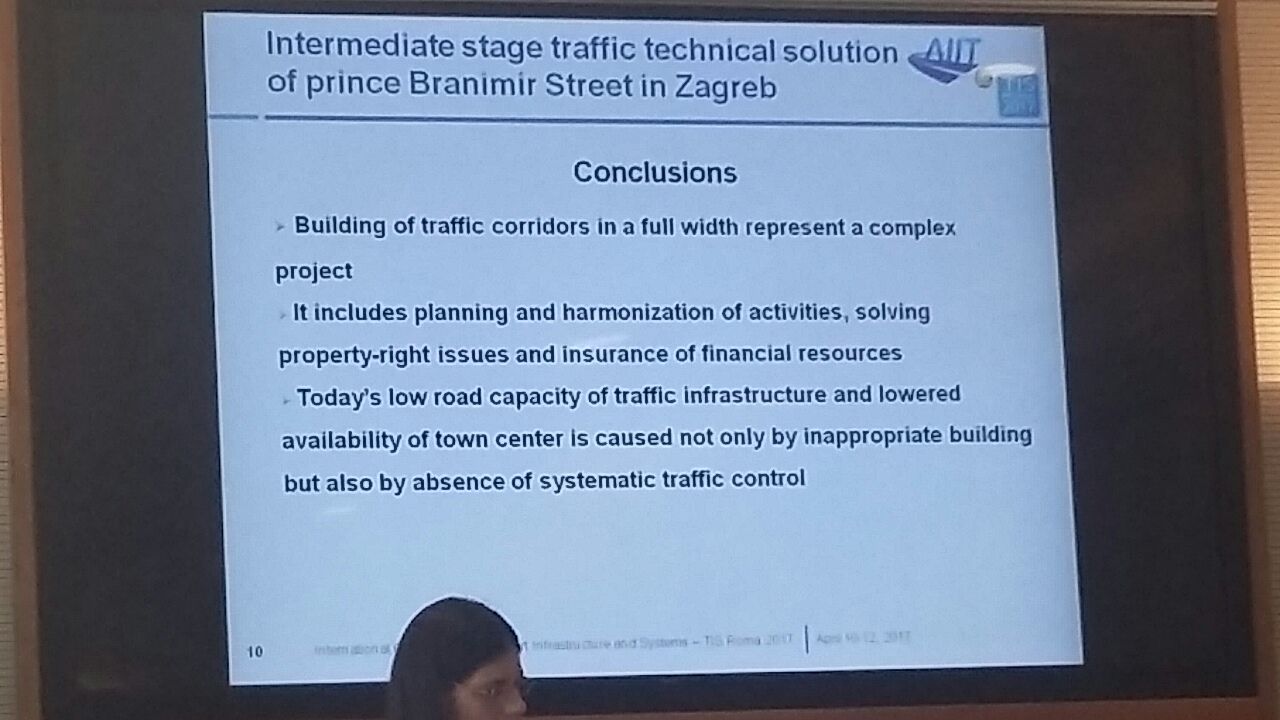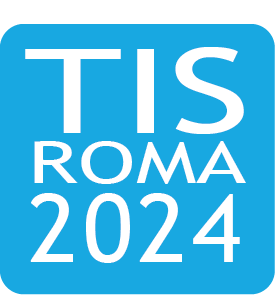TIS 2017
Session 9 – Road Safety Management

Professor Raffaele Mauro, Italian Road Infrastructures Society (SIIV) President, chaired this 9th very interesting session about Road Safety Management. During this session the most advanced applications and experiences of RSM were presented. It is well known that the problem of road safety is particularly significant and new methods to reduce the costs of motorized mobility due to road accidents, have been studied in various contexts.
Vittorio Astarita, Vincenzo Gallelli, Vincenzo Pasquale Giofrè, Giuseppe Guido, Carmine Demetrio Festa, Teresa Iuele, Domenico Mongelli, Daniele Rogano, Rosolino Vaiana and Alessandro Vitale – New features of Tritone a microsimulation model developed for the evaluation of traffic safety performances / Recent research papers have been devoted to the potential of traffic microsimulation for the analysis of road safety. In particular, some studies have confirmed that the reproduction by simulation of user behavior under different traffic flows and geometry conditions can identify near crashes events that are a good base to estimate real crashes risk. According to recent researches it appears that microsimulation tools can evaluate road safety performance and allow engineers to take appropriate countermeasures at specific points of the road network. The objective of the study presented was to showed a microsimulation model developed to estimate road safety performance through a series of indicators (Crash Potential Index, Rate Deceleration to Avoid Crash, Available Maximum Deceleration Rate, Time to Collision,etc..), representing interactions in real time between different pairs of vehicles belonging to the traffic stream. When these indicators take a certain critical value, a possible accident scenario is identified. Microscopic traffic flow parameters obtained by video detection are used to calibrate the microsimulation model and the safety performance indicators obtained by the real vehicles trajectories can be compared. However, to analyse traffic phenomena through detailed representation individual vehicle/driver behaviours, it is necessary a rigorous calibration and validation of the models to reproduce with a good fidelity the real phenomena. The study intends also to stimulate a discussion on this issue.
Giuseppe Guido, Vittorio Astarita, Alessandro Vitale, Vincenzo Gallelli and Frank Fedel Saccomanno – A new safety performance index for speed-related crashes / The use of GPS-equipped smartphones by drivers can facilitate the tracking and monitoring of vehicle operations in real-time. This kind of solution would be implemented to obtain estimates of individual vehicle operating speeds from the traffic stream. However, before GPS data can be used in safety performance analysis, tracking errors caused by en-route satellite signal disruptions need to be taken into account to accurately reflect real-world traffic conditions. The main aim of this study has demonstrated how, when adjusted for errors, GPS-based estimates of instantaneous speeds can be used to highlight locations where safety is compromised due to poor road geometry. A vehicle-specific Track Safety Performance Index (TSPI) is developed to measure the difference between individual vehicle operating speed and the design speed for the location. The results from two case studies support the use of error-adjusted GPS probe data for identifying sites where safety at a given location is compromised by driving too fast for the underlying geometric restrictions. Locations with higher TSPI values were found to correspond closely to sites with a higher number of speed-related crashes as reported over a period of five years. The results from the two case studies were found to be consistent in linking GPS probe estimates of TSPI to locations of higher crash risk.
Tao Chen, Mengxue Li, Lin Sun, Bin Chen and Yan Gao – Evaluation Method of Urban Intersection Safety under Mixed Traffic / The safety of intersections directly influences the traffic situation of the whole city. To improve intersection safety, this paper has presented an evaluation method of urban intersection safety based on traffic conflict technique (TCT) under mixed traffic involving vehicle, bicycle and pedestrian. The intersection risk degree is used as evaluation index, and the traffic conflict risk degree is calculated by using factors of Time-To-Collision(TTC), conflict speed and conflict angle. The conflict risk degrees include vehicle-vehicle conflict risk degree, vehicle-bicycle conflict risk degree and vehicle- pedestrian conflict risk degree. Then, the evaluation model of urban intersection safety is presented. Based on the model, the evaluation method is proposed using analysis of Vissim and SSAM (Surrogate Safety Assessment Model) Finally, series observation experiments are conducted to obtain the parameters of two urban intersections. The evaluation method is proved to be effective by the simulation.
Miroslav Simun, Sandra Mihalinac and Kazimir Rehlicki – Intermediate stage traffic technical solution of prince Branimir Street in Zagreb / Traffic network of each city is determined by urban master plan (UMP) which reflects in traffic corridors of specified width. The urban master plan presented is plan of the local level and in our case covers 220 km2 for the city of Zagreb. The plan explained gives indicators for the construction, renovation and protection of space in the area of Plans scope and to ensure spatial plan preconditions for realization of traffic and infrastructure projects. On the area of a large city is a complex interdependence of traffic infrastructure. The quality of traffic infrastructure is manifested as accessibility and mobility of space and advancement of new traffic corridors as a basis for a sustainable development. In this paper, the traffic technical solution of prince Branimir Street in Zagreb, road section from Zavrtnica to Vjekoslav Heinzel Street, has been elaborated. Construction of this road section was initiated in 2012 through the first phase of construction but only part of the width of the planned traffic corridor. As a result of that property-rights relations were partially solved. A fully built, in a full corridor width, was planned for second phase of construction. In the meantime the property-rights relations were solved but still not in a complete width of the planned corridor. Because of that, it has been approached to preparation of technical solution which would keep the elements constructed in a first phase, and built new ones in intermediate stage which would also be incorporated in a phase two of construction. In intermediate stage, elements which improve traffic conditions, should be constructed, such as enhancement of traffic capacity and satisfying level of service. In the paper were analyzed all the components and traffic technical solutions of intermediate stage.
The initial session program also included further presentations but for unpredictable reasons the speakers could not be present at the TIS congress.
Dario Bellini, Maria Carmela Iaconis and Matteo Rossi – correlation between risk level and operating speed of road section / The use of accident data has always been a challenge for the management of road networks in Italy. On one hand, there were many attempts to find theoretical models to interpret the data of accidents, while on the other arose the difficulty of finding quality data for targeted studies, especially for the rural road networks. In recent years however, the possibility of finding accident data was used to develop a useful procedure at a planning level to identify the road sections on which further investigation should be carried on, in order to improve road safety conditions. In the mentioned procedure two indexes were defined, the Anomaly Index and the Risk Index, representative of the dangerousness of each homogeneous sections a road network can be subdivided. The results obtained with the application of this procedure to some roads under the jurisdiction of the Tuscany Region Road Authority made possible to build some bubble diagrams, which allow an immediate and complete view of all homogeneous sections of the road network. For those sections for which we obtained a high risk level, deeper investigations were performed by measuring the operating speed, in order to evaluate a relationship between those detected discrepancies between the design conditions and the real operating condition of those homogeneous sections (correlated with the perception of the infrastructure by drivers) and the risk of these sections themselves, allowing the planning of those actions necessary in order to increase road and traffic safety level.
Jianfeng Xi, Lincan Wang, Tongqiang Ding and Weifu Sun – Classification and Recognition Model for the Severity of Road Traffic Accidents / In order to improve the classification accuracy and classification speed on the severity of road traffic accidents, the work proposed the method of classification and identification based on the combination of rough set theory and support vector machines (SVM). Rough set theory was used to calculate the significant degree of each attribute in “people, vehicles, roads and environment”. Based on the sorting of significant degree, the influencing factors of accident severity were dealt with feature extraction. Then the influencing factors with high significant degree were inputted into SVM. Taking general accidents and severe accidents as two classification labels, the work established the classification and identification model of the severity of road traffic accidents. At last, the validity of the method was analyzed and verified in the case of statistical data of road traffic accidents in one region of China. The results showed that the classification and identification model of the severity of road traffic accidents, based on rough set theory and SVM, can improve the accuracy of recognition and reduce the calculation work load of pattern identification. It has good classification and recognition as well as good generalization.
CHAIRMAN: Raffaele Mauro
